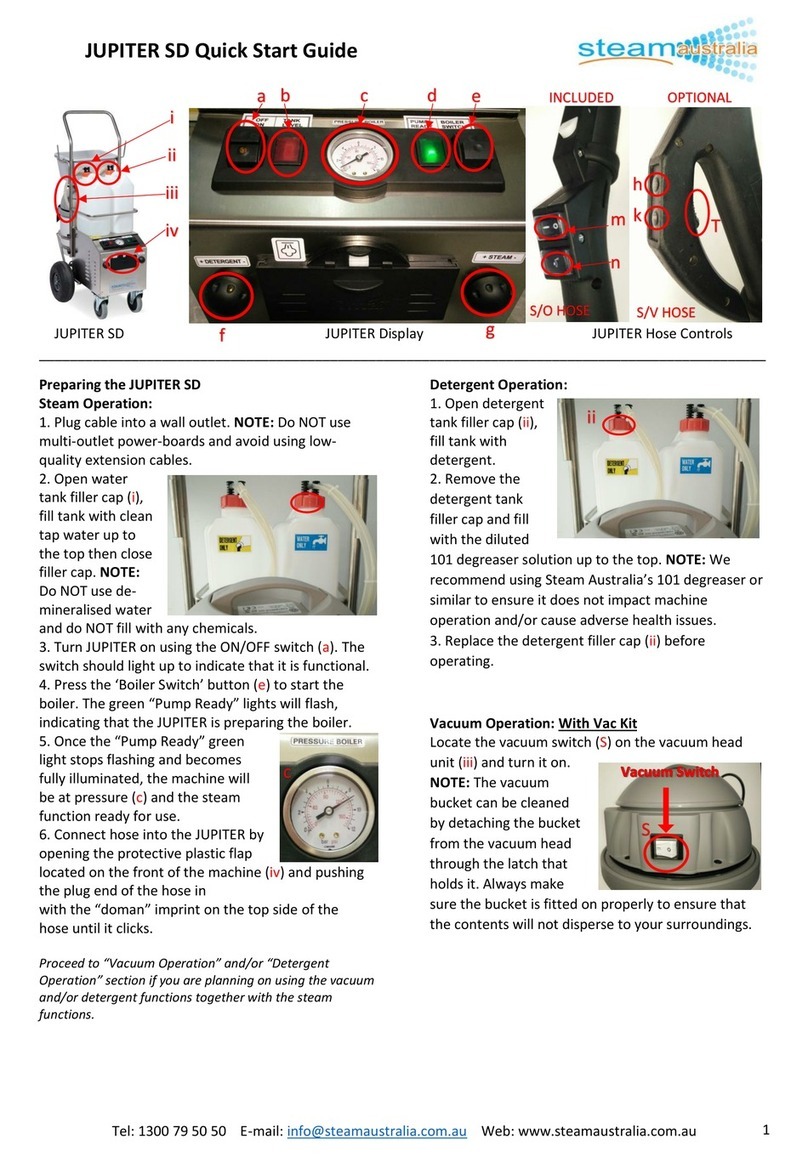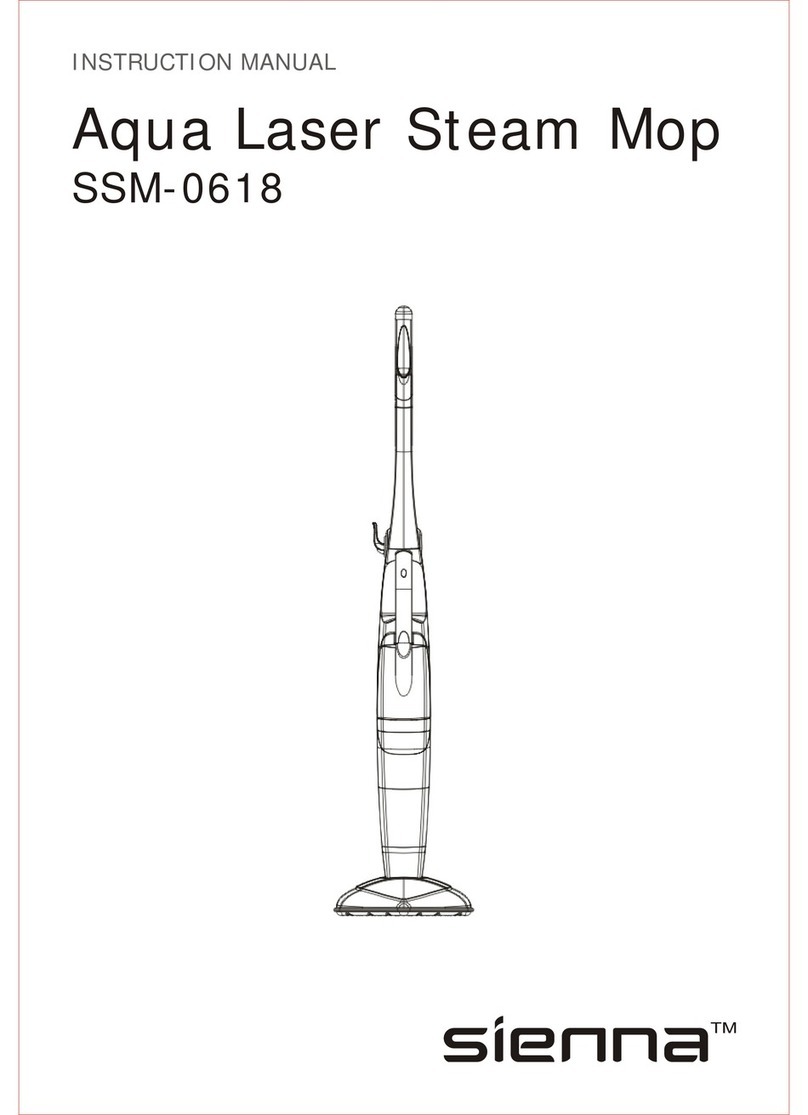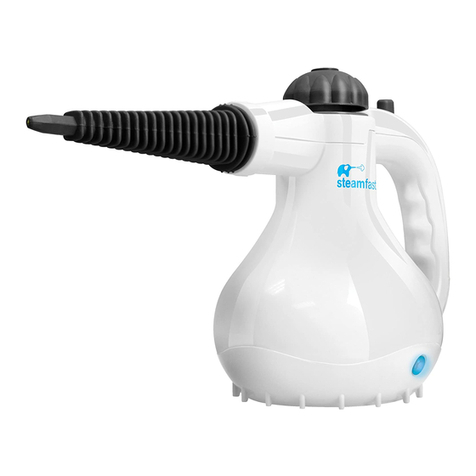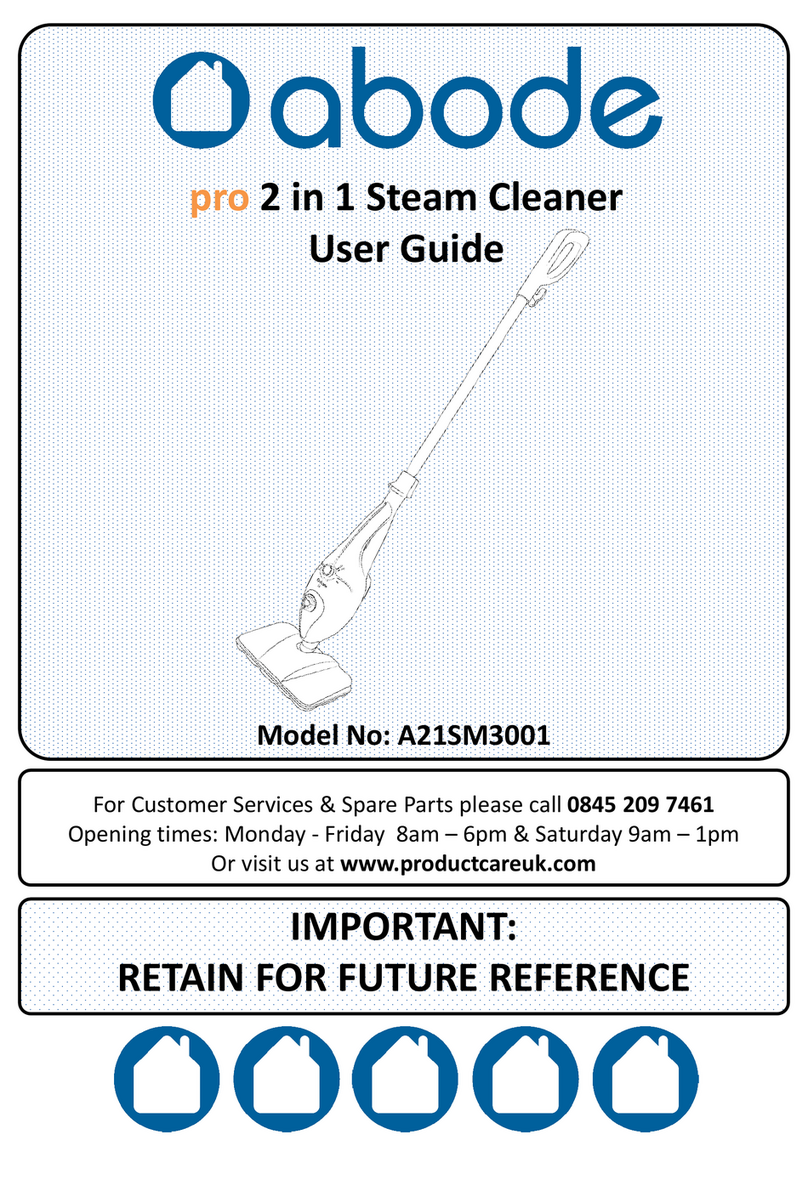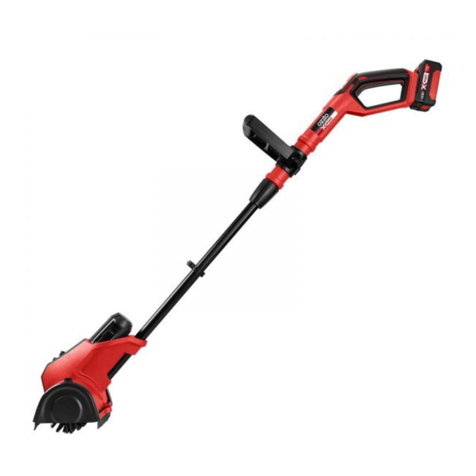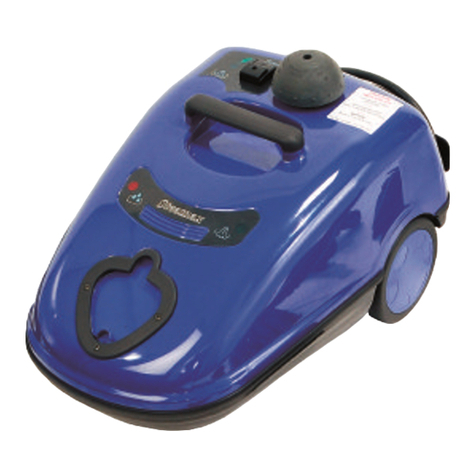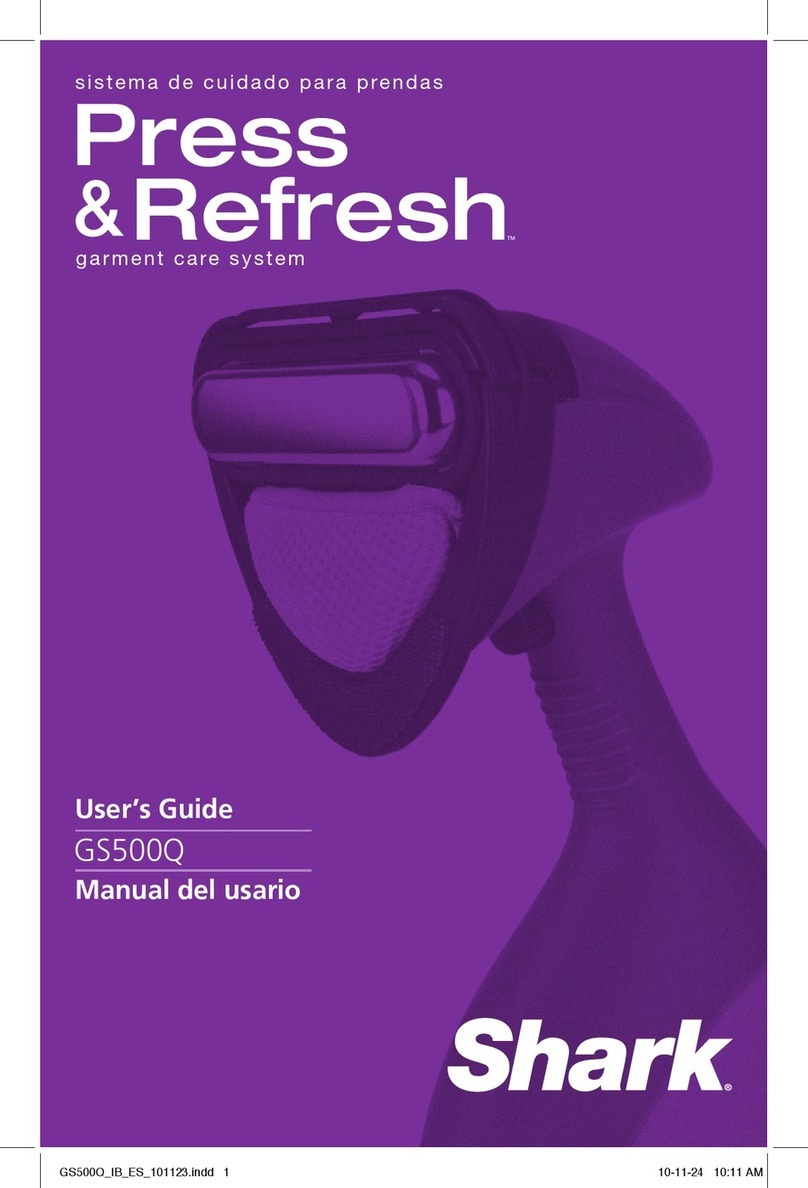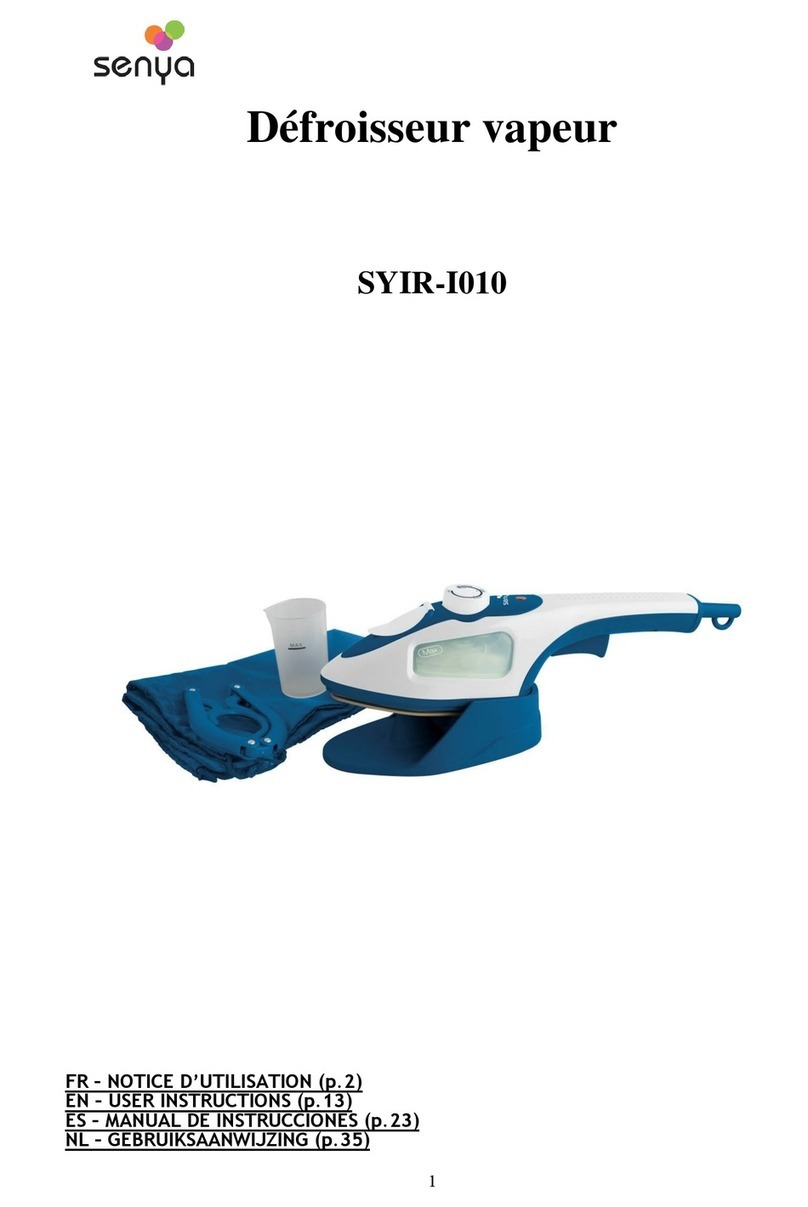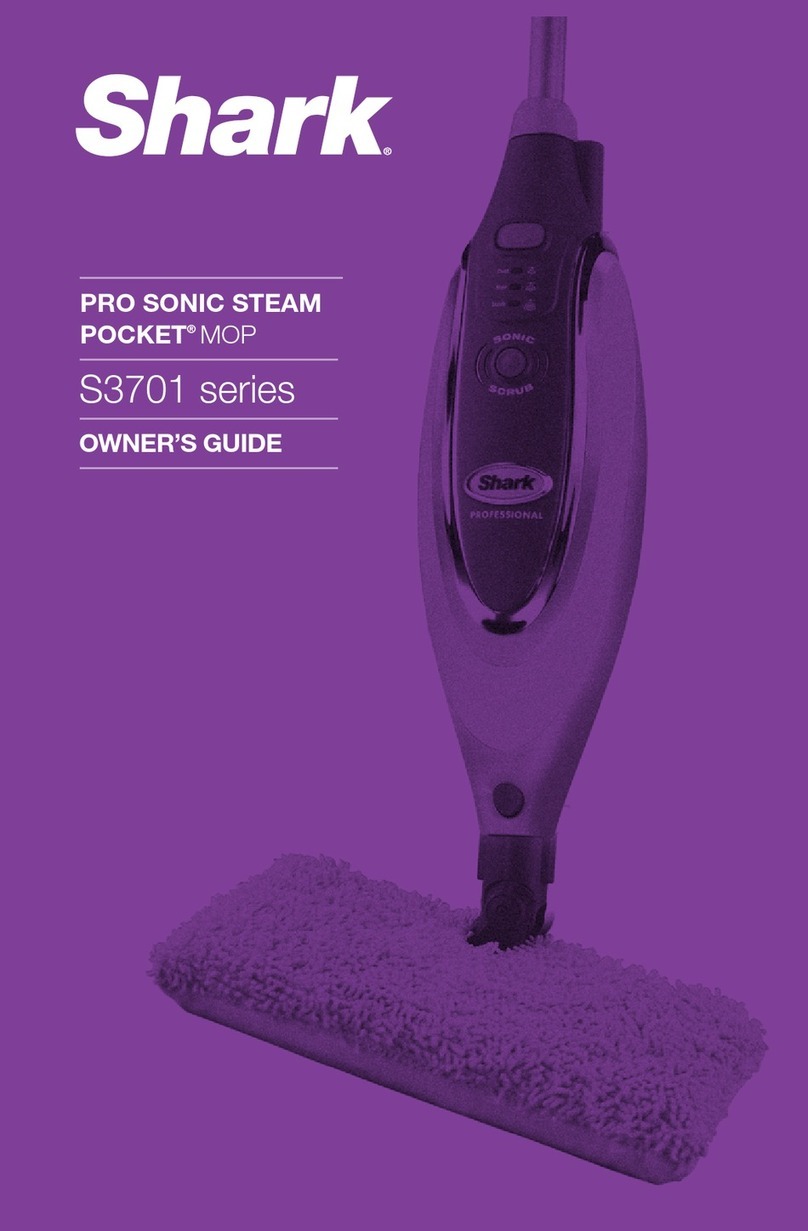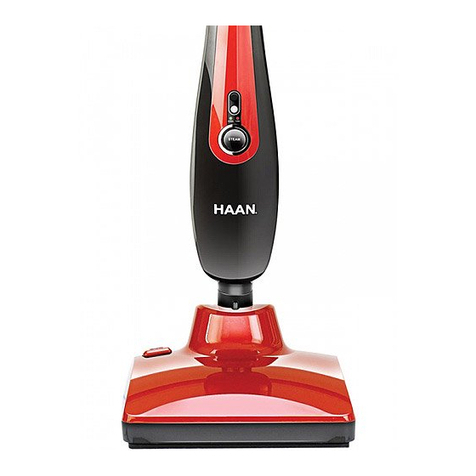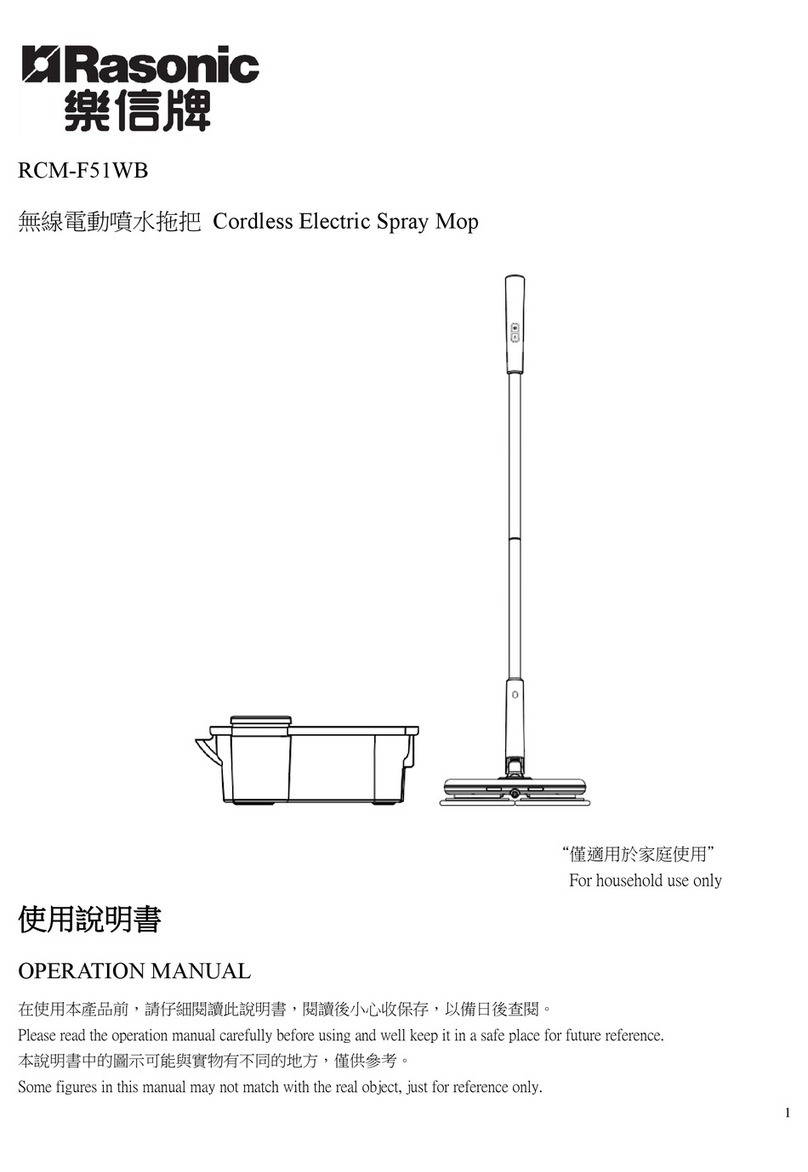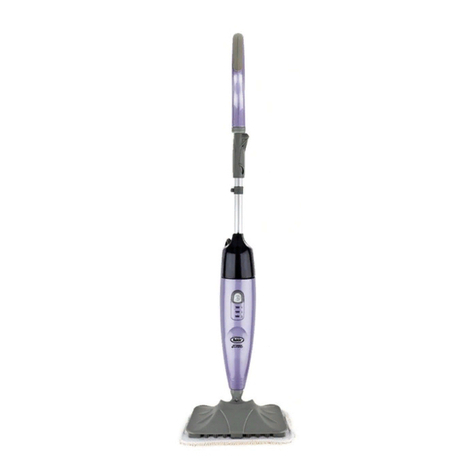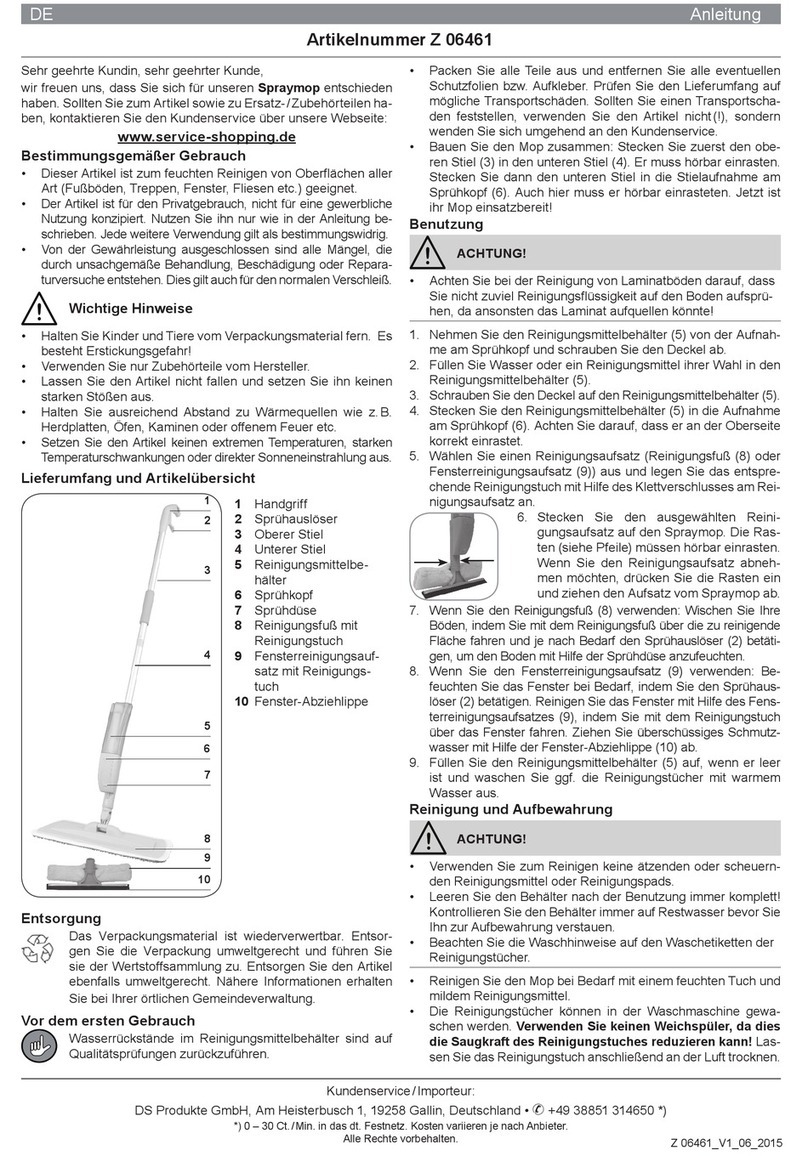Soba RD410 User manual

RD410
STEAM-CLEANER INSTRUCTIONS 2
DAMPFREINIGER GEBRAUCHSANLEITUNG 16
NETTOYEUR À VAPEUR MODE D’EMPLOI 30
PULITORE A VAPORE ISTRUZIONI PER L’USO 44

2
IMPORTANT SAFETY INSTRUCTIONS
When using your RD410, basic safety precautions should always be observed,
including the following:
• Read all instructions before using your RD410.
• Use the system only for its intended use.
• To protect against a risk of electric shock, do not immerse any part of the system
in water or other liquids.
• Never yank cord to disconnect from outlet; instead, grasp plug and pull to
disconnect.
• Do not allow cord to touch hot surfaces. Let the system cool completely before
putting away or opening water tank (removing the safety cap). Wrap cord loosely
around system when storing.
• Always disconnect system from electrical outlet when filling with water or
emptying and when not in use. Always turn the safety cap slowly when opening
the water tank. This will allow any remaining steam to escape gradually.
• Do not operate the system with a damaged cord or plug, or if the appliance or
any other part of the system has been dropped or damaged. To avoid the risk of
electric shock, do not disassemble or attempt to repair the RD410. Return the
system for examination and repair. Incorrect reassembly or repair can cause a
risk of electrical shock or injury to persons when the RD410 is used.
• Close supervision is necessary for any appliance being used by or near children.
Do not leave the system unattended while connected.
• Burns can occur from touching hot metal parts, hot water or steam. Use caution
when draining unit after use as there may be hot water in the unit. Never direct
steam at any person. The steam is very hot and can cause burns.
• Do not operate in the presence of explosive and/or flammable fumes.
• This appliance is intended only for household use. Follow all user instructions in
this manual.
• Never use any chemicals or other substances than tap water in the machine. Use
of chemicals may damage the machine. Use of chemicals will automatically void
your warranty.
RD410 STEAM-CLEANER INSTRUCTIONS

3
RD410 STEAM-CLEANER INSTRUCTIONS
To reduce the risk of fire, electric shock, or injury:
• Do not leave the RD410 plugged in when unattended. Unplug the electrical cord
when not in use and before servicing or refilling water tank.
• Do not allow to be used as a toy. Close attention is necessary when used by or
near children, pets or plants.
• Use only as described in this manual. Use only manufacturer’s recommended
accessories.
• Do not pull cord, use cord as a handle, close a door on cord, or pull cord around
sharp edges or corners. Keep cord away from heated surfaces.
• Do not use extension cords or outlets with inadequate current carrying capacity.
• Turn off all controls as applicable before unplugging from electrical outlet.
• Do not unplug by pulling on cord. To unplug, grasp the plug, not the cord.
• Do not handle plug or steam cleaner with wet hands or operate without shoes.
• Do not put any objects into openings. Do not use with any opening blocked.
• Store your appliance indoors in a cool, dry area.
• Keep your work area well lit.
• When in use, never turn the appliance over or on its side. Never direct steam
towards people, animals or plants.
• Do not immerse the steam cleaner into water or other liquids. Always unplug the
power cord from the electrical socket when filling the steam cleaner.
• Do NOT add cleaning solutions, scented perfumes, oils or any other chemicals to
the water used in this appliance as this may damage the unit or make it unsafe
for use. Use tap water or distilled/purified water if the tap water in your area is
very hard.
SAVE THESE INSTRUCTIONS. FOR HOUSEHOLD USE ONLY.

4
RD410 STEAM-CLEANER INSTRUCTIONS
ADDITIONAL IMPORTANT SAFEGUARDS
• To avoid circuit overload, do not operate another appliance on the same socket
(circuit).
• If an extension cord is absolutely necessary, a 8 ampere cord should be used.
Cords rated for less amperage may overheat. Care should be taken to arrange
cord so that it cannot be pulled or tripped over.
• Do not leave unattended when the system is connected to a power supply/
electrical outlet.
WARNING: This appliance is equipped with a grounded-type 3-wire cord (3-prong
plug). This plug will only fit into an electrical outlet made for a 3-prong plug. This is a
safety feature. If the plug should fail to fit the outlet, contact an electrician to replace
the outlet. Do not attempt to defeat the safety purpose of the grounding pin, part of
the 3-prong plug.
CAUTION: Always drain condensed water from hose before use or if unit has been
left idle for a period of time. To drain hose, direct nozzle into an appropriate container
or sink and depress hand grip steam trigger. Once hose has been drained, normal use
may be resumed. Never direct nozzle towards people, animals or plants.

5
GETTING TO KNOW YOUR RD410
1. Steam button
2. Power “On” Light (Amber)
3. Safety / Filler Cap
4. Hand Grip
5. Flexible Steam Hose
6. Extension Tubes (2)
7. Floor Brush
8. Detail Brush
9. Glass & Tile Squeegee
10. Concentrator Nozzle
11. Shoulder Strap
12. Angle Adapter
13. Filling Funnel
RD410 STEAM-CLEANER INSTRUCTIONS
TECHNICAL SPECIFICATIONS
Voltage: 230V / 50 Hz.
Power: 1560 Watts
Water Capacity: 0.8 lt
Max. Steam Temperature: 120° C
Steam Generator: Stainless Steel
1
10
9
8
7
6
5
4
3 2
11
13
12

6
RD410 STEAM-CLEANER INSTRUCTIONS
FEATURES OF RD410
• No more detergents or chemicals. Just add water.
• Lightweight & Portable
• Stainless Steel Boiler: Non-corroding, 18/10 stainless steel boiler. Welded
construction.
• Heavy-duty crush-proofhose.
• Versatile, quick-change accessories.
• Indoor and Outdoor Use: Bathrooms, kitchens, living areas, pet areas and
appliances. Automotive, patio and windows.
OPERATING INSTRUCTIONS
Components
Power “On” Light (amber): This light will illuminate when the unit is plugged into
the 230V~ wall outlet and will remain on until the unit is unplugged.
CAUTION: Read the instructions for “Filling the Water Tank” before opening the
Safety Cap. Always depress hand grip steam trigger until all pressure/steam has been
vented from boiler. Always unplug before filling.
IMPORTANT: Do NOT add cleaning solutions, scented perfumes, oils or any other
chemicals to the water used in this appliance. Use tap water or distilled/purified water
if the tap water in your area is very hard.
Filling Your RD410 with Water
1. Before filling the RD410, make sure that the unit is NOT plugged in.
2. Turn Safety/Filler Cap (3) counter clockwise until removed.
3. Place Water Filling Funnel in tank and add 0.8 lt of water. Do not overfill. Replace
Safety/Filler Cap by turning clockwise. Heating time is approximately 3-5 minutes
with cold water. Filling boiler with hot water will shorten heat up time.
4. Plug the unit into a standard 230 volt (3-prong) grounded wall receptacle. The
power light will illuminate.
5. Allow approximately 3–5 minutes for vapor to reach its working temperature and
pressure.
6. Connect desired attachments onto the Flexible Steam Hose.
7. Upon initial use, some water will come out from the nozzle of the attachment.
This is unheated water in the hose and is normal.
CAUTION: Allow unit to cool for 5 minutes before refilling. When refilling the
machine while it is still hot, the first drops of water might bubble up. Use caution
when opening the Safety/Filler Cap as cap may become hot during use and escaping
steam can cause scalding.
IMPORTANT: When the RD410 has run out of water, steam output will cease.
CAUTION: Always drain condensate from hose before use or if unit has been left idle
for a period of time. To drain hose, direct nozzle into an appropriate container or sink
and depress hand grip steam trigger. Once hose has been drained, normal use may
be resumed. Never direct nozzle towards people, animals or plants.

7
Refilling Your RD410 with Water
1. Disconnect Electrical Power Cord from wall outlet.
2. Depress and hold the hand grip steam trigger to ensure that any remaining
pressure in the boiler has been released.
3. Carefully loosen the safety/filler cap by turning counter clockwise. Any residual
steam will be released below the safety/filler cap if the tank has not been
completely vented. When the hissing stops and the last of the steam has been
released, remove the filler cap.
CAUTION: Allow unit to cool down for 5 minutes. Escaping steam can cause
scalding.
4. Refill water tank with water using the filling funnel.
5. Firmly screw the safety/filler cap back onto the unit by turning clockwise.
6. Connect power cord to the wall outlet.
Using Your RD410 with Floor Brush
1. Connect one of the extension tubes to the hand grip on the flexible steam hose.
To attach the extension tubes one onto the other or onto the hand grip, press the
locking button ensuring that it fits into the hole (see illustrations.) To disconnect,
repeat the operation by pressing the locking button and pulling the two sections
apart.
RD410 STEAM-CLEANER INSTRUCTIONS
NOTE: Fit floor brush with the angle adapter on to the extension tube.
2. If the angle adapter is not attached to the floor brush, hold the brush with its
bristles up in your left hand. With the angle adapter pointing downward, insert it
into the hole in the back of the brush, then turn the angle adapter 180°.
3. Insert the electrical power cord into the wall outlet. Heating time is approximately
3–5 minutes with cold water. Filling the steam generator with hot water will
shorten heat up time.
Security button
Handle
Security button
Extension tubes

8
RD410 STEAM-CLEANER INSTRUCTIONS
Attaching a Towel to the Floor Brush
100% white terry cloth towel can be fitted on this brush so as to absorb the dirt and
protect delicate surfaces. It can also be used on vertical washable surfaces following
the same procedure as for the floor.
IMPORTANT: Please note that bristles may break through thin towels. If you don’t
have thick enough towels, please use 2 towels.
1. Prepare white terry cloth towel (dimensions 34 cm x 40 cm).
2. Place the brush on the towel.
3. Fold the towel.
4. Fold the other side of the towel.
5. Place the corner under the cloth holder.
6. Place the towel around the brush, and repeat folding the towel.
When folding the towel, leave some slack. Do not pull tightly
around the brush.
ATTACHING THE ACCESSORIES TO THE FLEXIBLE STEAM HOSE
Dual Edge Glass & Tile Squeegee
This attachment is very useful for cleaning large windows, plastic material, ceramic,
tiled or marble surfaces.
To use: Connect the tile squeegee to the hand grip or use with extension tube for
hard to reach surfaces.
Apply steam abundantly, rub with the soft spongy edge, then remove excess water
and dirt with the glass wiping edge.
CAUTION: When cleaning windows, always avoid any sudden changes in temperature
to prevent glass breakage or cracks.
Concentrator Nozzle
This attachment is very useful for cleaning surfaces that are difficult to reach. It
is ideal for radiators, door and window jambs, shutters and sanitary fixtures. The
concentrator nozzle will fit directly onto the handgrip or may be used with extension
tubes.
Detail Brush
It is best for cleaning grout in-between the tiles, ceramic and marble.
To use: Push the detail brush on the end of the concentrator nozzle, which may be
used directly on the hand grip or with extension tubes.

9
TIPS ON HOW TO USE YOUR SYSTEM
Water
• Use tap water for all your cleaning needs.
• However, if you live in an area with hard water, use demineralised/distilled water
when steaming light colored fabrics to eliminate the possibility of hard water
stains.
IMPORTANT: Do NOT add cleaning solutions, scented perfumes, oils or any other
chemicals to the water used in this appliance. Use tap water or distilled/purified water
if the tap water in your area is very hard.
Temperature
• The vapor temperature at the tip of the nozzles is between 105° C and 115° C.
• The temperature of the vapor falls to 38° C at a distance of 25 cm from the
nozzle.
WARNING: A towel wrapped around the brush can become hot enough to burn.
Make sure that you let the towel cool off before touching it.
Using Towels
• For best results use 100% cotton white terry cloth towels.
• Use correct size (34 cm x 40 cm) of towel to allow you to wrap the towel around
the brushes and clip it under the spring loaded cloth holder.
• The purpose of using a towel is to absorb moisture and dirt being removed.
Always use dry towels. A wet towel will smear the dirt.
• Wash towels with strong detergent and bleach.
• Using scented fabric softener while washing the towels will cause the scent to be
released into the air when using the towels with your steam system.
Efficient Work
• For vertical surfaces, wipe always from the top down, in this way the dirty water
will not soil surfaces already cleaned.
• Avoid changing brushes back and forth while cleaning.
• Start with the smallest brush to clean tight spots and corners first.
• Wipe dirt as soon as possible, otherwise it will dry and re-adhere to the surface.
RD410 STEAM-CLEANER INSTRUCTIONS

10
USAGE SUGGESTION FOR RD410
Wood, Vinyl and Marble Floors
Use the floor brush with a terry cloth attached. Move the brush across the floor as if
you are mopping. When the towel is soiled, you can turn the towel over or replace it
with a clean towel. If you are working on a very dirty area, you can move the brush
over the area slowly, several times. If it is a wood floor, move fast to avoid heat or
moisture buildup in the wood. By cleaning with the towel over the brush, you will not
affect the shine on the floor.
To Strip Wax
Use floor brush for open areas; detail brush for corners or tight areas - no towel,
slow strokes. Work a small area at a time - remove the emulsified wax from the floor.
When all of the wax has been stripped, immediately clean the floor and brushes with
water before residue has a chance to harden on them. Go back over the stripped area
with the floor brush with a towel to remove any remaining residue before waxing.
To Clean Waxed Floors
Wrap clean towel around the floor brush, brush quickly. This will cause the dirt to be
removed but not the wax.
Vinyl Floors
Do not allow heat to buildup in any kind of vinyl, since it can soften it enough to affect
its texture. Work fast on vinyl.
Tile Floors
Use the detail attachment with the detail brush attached to an extension. Have the
floor brush with cloth attached ready as well. Clean the grout between the tiles with
the detail brush. Remove the detail brush and attach the floor brush, move the brush
across the floor to clean the tile and remove excess moisture and residue. For areas
of tile that are very dirty, remove the towel and agitate with the brush. Do not let the
area dry before you wipe it up.
Spot Cleaning (Carpets)
Use the concentrator nozzle with or without the detail brush. Move slowly over the
soiled area, allowing the steam to penetrate. Agitate with detail brush or clean
towel. Dab the spot with the towel (do not rub). Repeat as necessary to remove
stain. Vacuum only after the carpet has completely dried. Always test color fastness
of carpet in an inconspicuous area before cleaning. If your RD410 fails to remove
stubborn stains a commercially available carpet shampoo may be required.
Do NOT add cleaning solutions, scented perfumes, oils or any other chemicals to the
water used in this appliance as this may damage the unit or make it unsafe for use.
RD410 STEAM-CLEANER INSTRUCTIONS

11
Upholstery
Use the floor brush attached directly to the hand grip with a clean white terry cloth
towel. Use fast, light strokes, avoid getting the fabric wet. Be patient with stubborn
spots; work on a spot gently for no more than a minute at a time, then wait five
minutes for the area to dry and repeat. Use circular movements or back-and-forth
and side-to-side movements to get all sides of surface fibers. Finish with a brushing
in one direction that will give the fabric a uniform appearance.
CAUTION: Always determine the color-fastness of any fabric - especially with reds or
blues - by taking a clean, moist, warm towel and gently rubbing a small area as far
down on the back or other out of the way place on the furniture as possible. If color
comes off on the towel, you may need to have the piece dry cleaned.
Window, Glass Surfaces and Mirrors
Use the dual edge glass and tile squeegee. Work with the vapor jet on using the top
to bottom movements. Use the squeegee with the vapor off to clear the water from
the glass. To do this without leaving streaks, use lateral movements from the top to
the bottom of the surface.
Fiberglass or Stainless Steel Surfaces
Use the floor brush or detail brush. Slowly move the brush over the surface to be
cleaned. The vapor will emulsify the dirt and grease on the surface. Follow behind
with a terry cloth towel over the brush to remove excess moisture and residue.
Tip: An old idea for polishing stainless steel is to wipe it down with seltzer soda water
after it is cleaned.
Soap Scum
Soap scum dissolves almost immediately under a combination of heat and moisture.
Rinse the surface with a small amount of water afterwards or go back over it once
more with a clean terry cloth towel.
Note: Soap scum sometimes will develop a hard surface from waterborne minerals.
If this is the case, use the floor brush with no towel first to break up this surface - or
spray or wipe first with lemon, vinegar or seltzer soda water to soften the minerals.
Moving too slowly can dry out the soap scum and cause it to granulate on the surface.
The surface will have a gritty feel. If this happens, apply vapour to the surface with
the open brush again and reclean.
Garden Furniture
Use any of the brushes depending on the surface area. Work quickly when cleaning
resin outdoor furniture.
Blinds
Use the detail brush to clean blinds. Move the brush over the surface, allowing
enough time for the vapor to penetrate. Work quickly on PVC blinds. Test for color
fastness on fabric blinds before using.
RD410 STEAM-CLEANER INSTRUCTIONS

12
Bathroom Areas
To clean the bathtub or shower area, use the detail brush for grout, shower door
tracks, hard to get areas and heavily soiled areas. The dual edge window/tile
squeegee will be the most efficient way to clean the rest of the area. Allow plenty
of time for the heat to penetrate the surface. This is especially helpful in the shower
area if there is tile or grout. Removal of soap scum on tile, grout, and shower doors
is also easier with the RD410.
To clean sanitary fixtures, use concentrator nozzle with or without detail brush. Use a
terry cloth towel or paper towel to wipe up excess moisture and residue.
To clean the sink and faucets, use detail brush.
Exterior Areas
To clean inside your car, use the floor brush with a terry cloth towel attached to clean
upholstery and interior areas just as in the home. You should not expose the bristles
to leather - use only the brush with the terry cloth towel attached. For detailing
the wheels, use the concentrator nozzle and the detail brush. Exterior windows are
cleaned best by applying the vapor with the concentrator nozzle and following with
a paper towel.
To clean bicycles, use the detail brush. To clean equipment, use the detail brush,
depending on the surface area.
Artificial Plants
Use the concentrator nozzle without a brush attached to blow off the dust and dirt.
Clothing
A vapour cleaning system is excellent for removing wrinkles from fabrics. Simply
“vaporize” the surface from a distance of 30-45 cm. The dry vapor removes wrinkles
without leaving the fabric wet like ordinary fabric steamers do.
Nicotine and Tar
Nicotine and tar dissolves at high temperatures and becomes a light yellow oil that
has the consistency of sewing machine oil. When the nicotine/tar film is touched by a
hot terry cloth towel clipped over the floor brush, it immediately dissolves and flows
into the towel. You can remove it from flat surfaces as fast as you can move the brush
over the surface.
Removing Wax, Tar, Etc.
Many stains are only stuck on the surface of materials and can be easily and quickly
removed by “blowing” excess material away from the surface from the side. This is
accomplished by using the concentrator nozzle. Hold the terry cloth towel to the side
to catch the loose residue as it is blown by the nozzle.
Note: Always vacuum any loose residue off the surface before you apply vapor to
it.
RD410 STEAM-CLEANER INSTRUCTIONS

13
Hints: The RD410 has many uses that have not been mentioned. This was meant
only to give you a general idea of what can be achieved with the unit. However, the
ways in which to use the attachments and brushes are in most cases universal. It
is most helpful to always have a terry cloth towel or paper towel ready to use for
removal of moisture and residue. 100% white cotton towels work best. You can
clean the brushes with your steam cleaner. To clean the floor brush, hold at one end
and use the concentrator nozzle to simply blow off dirt into the garbage can. When
cleaning the detail brush, use a pair of pliers to hold and blow dirt as above or place
in the basket of your dishwasher.
Note: Wipe immediately before the cleaned area dries. When cleaning the oven, use
the detail brush to clean around the elements and drip trays. Use the detail brush for
cracks, crevices, and hard to reach areas.
Refrigerator
Use the concentrator nozzle to blow away dirt in the ice machine and on door seals.
The vapor will not dry out or crack the seals as chemicals often do. Can openers and
other kitchen equipment can be easily cleaned with the detail brush on the nozzle to
get into all the nooks and crannies. Mold stains around door gaskets can be removed
with the detail brush.
To clean microwaves or other small appliances use the detail brush for small areas.
Note: When cleaning small electrical appliances always unplug them from outlet
before cleaning.
To clean counter tops, use the floor brush with a terry cloth towel attached. For
heavily soiled areas, use the brush without the terry cloth towel first in order to
loosen the debris, then follow with a terry cloth towel attached to finish.
RD410 STEAM-CLEANER INSTRUCTIONS

14
CARE & MAINTENANCE
If you consistently use demineralized or distilled water, cleaning the tank is
unnecessary.
Rinsing out the steam cleaner:
Normally, a periodic rinse of your RD410 will free it from deposits. This is
recommended every 10–15 tankfulls, to free up any scale deposits from the tank. Fill
the boiler with water and shake the cleaner vigorously. Tilt the cleaner upside down
to empty the boiler of water and any scale deposits.
Descaling your steam cleaner
If the tap water in you area contains a high level of calcium deposits and you have
been using tap water to do your steam cleaning, you should descale your unit after
10-15 tankfulls.
1. Unplug the steam cleaner from the power source before you descale the boiler.
2. Fill the boiler with 1 part (150 ml) vinegar and 4 parts (600 ml) water and leave
overnight or for a period of approximately 8 hours. Do not screw the safety/filler
cap onto the steam cleaner while you are descaling the boiler. Do not use the
steam cleaner while descaling solution is inside the boiler.
3. After the period of soaking, turn the steam cleaner upside down to empty solution
from the boiler. Due to the fact that a small amount of solution will be left in the
boiler, it is necessary to rinse the boiler out with clean water 2 or 3 times. Your
steam cleaner is now ready for use.
ATTACHING THE SHOULDER STRAP
Using the detachable shoulder strap allows for greater freedom of movement when
both hands are needed for various cleaning tasks.
To attach the shoulder strap to the steam cleaner, simply snap the shoulder strap
hooks onto the connecting rings on the unit body.
When using the RD410 with the shoulder strap, avoid rocking or tilting the unit
excessively as this may cause water to enter the hose and be discharged along with
the steam.
RD410 STEAM-CLEANER INSTRUCTIONS

15
RD410 STEAM-CLEANER INSTRUCTIONS

16
WICHTIGE SICHERHEITSHINWEISE
Wenn Sie den RD410 benutzen, beachten Sie immer diese allgemeinen und auch die
folgenden besonderen Sicherheitshinweise:
• Aufmerksam die Anleitungen lesen, bevor Sie den RD410 verwenden.
• Verwenden Sie das Gerät nur bestimmungsgemäß.
• Um die Gefahr von Stromschlägen zu vermeiden, tauchen Sie keinen Teil des
Gerätes ins Wasser oder in andere Flüssigkeiten.
• Um das Gerät aus der Steckdose zu entfernen, nicht am Stromkabel, sondern am
Netzstecker ziehen.
• Die Kabel dürfen nicht mit heißen Teilen in Berührung kommen. Lassen Sie das
Gerät gut abkühlen, bevor Sie es wegräumen oder bevor Sie den Wassertank
öffnen (den Sicherheitsverschluss aufdrehen). Vor dem Wegräumen wickeln Sie
das Kabel nur lose um das Gerät.
• Das Gerät immer von der Stromversorgung trennen, bevor Sie es füllen oder
Wasser ausgießen, oder wenn es nicht verwendet wird. Den Sicherheitsverschluss
langsam aufdrehen, um den Tank zu öffnen, so dass der restliche Dampf
kontrolliert entweichen kann.
• Das Gerät nicht mit einem beschädigten Kabel oder Stecker benutzen, oder wenn
das Gerät oder die Zubehörteile beschädigt oder gefallen sind. Um die Gefahr
von Stromschlägen zu vermeiden, versuchen Sie nicht, das Gerät zu zerlegen
oder es zu reparieren. Übergeben Sie ein defektes Gerät dem autorisierten
Kundendienst. Durch unsachgemäße Reparatur oder Montage des Gerätes kann
die Gefahr von Stromschlägen für die Benutzer entstehen.
• Das angeschaltete Gerät nie unbeaufsichtigt lassen, besonders wenn Kinder in
der Nähe sind.
• Der Kontakt mit heißen Metall-Teilen, heißem Wasser oder Dampf kann
Verbrennungen verursachen. Lassen Sie sehr vorsichtig Wasser aus dem Gerät
herauslaufen, weil das Wasser im Gerät sehr heiß sein kann. Den Dampfstoss nie
gegen Menschen oder Haustiere richten (Der Dampf ist sehr heiss und kann zu
Verbrennungen führen).
• Das Gerät nicht in der Nähe von entzündbarem und/ oder explosivem Material
verwenden.
• Das Gerät ist nur zum Haushaltsgebrauch geeignet. Bitte aufmerksam allen
Gebrauchshinweisen dieser Anleitung folgen.
• Keine Chemikalien oder andere Stoffe als Leitungswasser verwenden. Die
Verwendung von Chemikalien kann das Gerät beschädigen. Außerdem hebt die
Verwendung von Fremdstoffen automatisch den Garantieanspruch auf.
RD410 DAMPFREINIGER GEBRAUCHSANLEITUNG

17
RD410 DAMPFREINIGER GEBRAUCHSANLEITUNG
Zur Vermeidung von Hitzeschäden, Stromschlägen oder Unfällen:
• Das Dampfgerät RD410 nicht an die Stromversorgung angeschlossen lassen,
wenn es nicht gebraucht wird. Bei Instandhaltungsarbeiten, Auffüllen oder
Ausleeren in jedem Fall den Netzstecker ziehen.
• Das Gerät nicht als Spielzeug verwenden. Passen Sie bitte auf, wenn es neben
Kindern, Tieren oder Pflanzen verwendet wird.
• Zum Gebrauch nur den Hinweisen in dieser Anleitung folgen. Ausschließlich das
vom Hersteller empfohlene Zubehör verwenden.
• Am Stromkabel nicht fest ziehen und darauf achten, dass es nicht unter Türen
oder an spitzen Ecken und Kanten scheuert; das Kabel von Wärmequellen
fernhalten.
• Keine Verlängerungskabel oder Anschlüsse mit ungeeigneten Werten
verwenden.
• Nicht am Kabel oder am Gerät selbst ziehen, um den Netzstecker aus der
Steckdose zu ziehen.
• Den Stecker oder das Dampfgerät nicht mit nassen Händen greifen und es nicht
barfuss verwenden.
• Keine Gegenstände in eine der Öffnungen stecken. Das Gerät darf mit irgendeiner
blockierten Öffnung nicht verwendet werden.
• Bewahren Sie das Gerät in einem trockenen, belüfteten Raum auf.
• Arbeiten Sie nur in ausreichend hellen Räumen.
• Das Gerät nur waagrecht benutzen, nicht umkehren oder neigen. Den Dampfstoß
nicht gegen Menschen, Tiere oder Pflanzen richten.
• Das Dampfgerät nicht in Wasser oder andere Flüssigkeiten tauchen. Beim Füllen
des Gerätes immer das Stromkabel aus der Steckdose ziehen.
• Dem Wasser keine Reinigungsmittel, Parfüm, Öle oder andere Chemikalien
beifügen, weil sie das Gerät beschädigen könnten. Nur sauberes Leitungswasser
oder demineralisiertes Wasser benutzen, wenn Leitungswasser sehr kalkhaltig
ist.
BITTE DIESE ANLEITUNG FÜR SPÄTERES NACHLESEN AUFBEWAHREN. DAS GERÄT
IST NUR ZUM HAUSHALTSÜBLICHEN GEBRAUCH BESTIMMT.

18
RD410 DAMPFREINIGER GEBRAUCHSANLEITUNG
ALLGEMEINE SICHERHEITSREGELN
• Um einen Kurzschluss zu vermeiden, kein anderes Gerät an derselben Steckdose
verwenden.
• Wenn ein Verlängerungskabel unbedingt notwendig ist, ein Kabel für 8 Ampere
mit dem passenden Querschnitt benutzen. Zu schwache (dünne) Kabel können
überhitzen. Beim Kabel bitte auch beachten, dass es nicht weggezogen werden
kann und niemand stolpern kann. Das Kabel muss dabei immer aufgerollt sein.
• Das Gerät nie unbeaufsichtigt lassen, wenn es an einer Steckdose angeschlossen
ist.
VORSICHT: das Gerät ist mit einer geerdeten Leitung mit dreipoligem Stecker
ausgestattet. Dieser Stecker ist nur an einer dafür geeigneten Steckdose
anzuschließen. Das ist eine wichtige Sicherheitsmassnahme. Wenn die Steckdose für
den Stecker nicht geeignet ist, mit einem Elektriker Kontakt aufnehmen, um sie zu
ersetzen. Versuchen Sie nie, die Sicherheitsvorrichtung der Erdung zu entfernen.
WARNUNG: Immer das Kondenswasser, das sich im Schlauch bildet, abfließen
lassen, bevor das Gerät benutzt wird, auch dann, wenn es während einer gewissen
Zeit nicht verwendet wurde. Um das Wasser aus dem Schlauch abfließen zu lassen,
die Düse in einen dazu bestimmten Behälter oder in das Spülbecken richten und den
Betätigungsknopf am Griff drücken. Wenn der Schlauch leergeflossen ist, kann man
das Gerät wieder benutzen. Auch hier gilt, die Düse nie gegen Menschen, Tiere und
Pflanzen zu richten.

19
FUNKTIONSTEILE
1. Dampftaste
2. Kontroll-Leuchte EIN/AUS
3. Sicherheitsverschluss
4. Griffbügel
5. Flexibler Dampfschlauch
6. Verlängerungsrohre (2)
7. Bürste für Fußboden
8. Rundbürste für Punktbehandlung
9. Glasreiniger für Glasflächen und Fliesen
10. Dampfdüse für konzentrierte Anwendung
11. Tragegurt
12. Winkelzwischenstück (Adapter für Bürste)
13. Einfülltrichter
RD410 DAMPFREINIGER GEBRAUCHSANLEITUNG
1
10
9
8
7
6
5
4
3 2
11
13
12
TECHNISCHE DATEN
Stromversorgung: 230V 50 Hz.
Leistung: 1560 Watt
Wasserfüllmenge: 0,8 Liter
Max. Dampftemperatur: 120° C
Dampferzeuger: Drucktank aus
Edelstahl, rostfrei

20
RD410 DAMPFREINIGER GEBRAUCHSANLEITUNG
DIE EIGENSCHAFTEN DES RD410
• Keine Reinigungsmittel oder andere Chemikalien beifügen, nur Wasser verwenden.
• Leicht und einfach tragbar
• Drucktank aus Edelstahl 18/10, geschweißt, rostfrei
• Druckfester, strapazierfähiger Schlauch
• Mehrzweckzubehörteile, einfach zu benutzen
• Zum Gebrauch im und um das Haus. Bäder, Küchen, Wohnzimmer, Bereiche für
Haustiere, Fenster, Terrasse, Balkon und Teile am Auto.
BEDIENUNGSHINWEISE
Bestandteile
Kontroll-Leuchte EIN/AUS: Sie leuchtet auf, wenn der Stecker in eine 230V
Wandsteckdose gesteckt wird und leuchtet weiter, so lange, bis der Stecker gezogen
wird.
WARNUNG: Aufmerksam die Hinweise “Befüllen des Wassertankes” lesen, bevor
man den Sicherheitsverschluss öffnet. Vor dem Öffnen den Dampfknopf drücken, bis
restlicher Dampf und Druck aus dem Tank ausgetreten sind. Vor dem Füllen des
Tankes den Stecker aus der Steckdose ziehen.
WICHTIG: Keine Reinigungsmittel, Duftstoffe, Öle oder andere Chemikalien
hinzufügen. Nur Leitungswasser oder destilliertes bzw. demineralisiertes Wasser
benutzen, wenn das Leitungswasser sehr kalkhaltig ist.
Das Befüllen des Wassertankes
1. Versichern Sie sich, dass das Gerät während des Auffüllens bzw. Wiederauffüllens
des Tankes nicht an das Stromnetz angeschlossen ist.
2. Drehen Sie den Sicherheitsverschluss (3) im Gegenuhrzeigersinn, bis Sie ihn
abnehmen können.
3. Ca. 0,8 l Wasser mit dem beiliegenden Trichter eingießen, bis der Kessel gefüllt ist.
Achten Sie darauf, dass kein Wasser überläuft. Danach den Sicherheitsverschluss
im Uhrzeigersinn aufschrauben. Die Aufheizzeit beim kalten Wasser beträgt ca
3–5 Minuten. Beim Einfüllen von heißem Wasser verkürzt sich die Aufheizzeit.
4. Den Stecker in eine richtig geerdete Wandsteckdose (230V) stecken, danach
leuchtet die Kontroll-Lampe auf.
5. Ca. 3–5 Minuten warten, bis der Dampf die richtige Temperatur und Druck
erreicht hat.
6. Die Zuberhörteile, die man benutzen will, in den flexiblen Schlauch stecken.
7. Am Anfang kann noch Wasser aus den Düsen austreten. Das ist Restwasser, das
sich noch in den Düsen befinden kann.
ACHTUNG: Warten Sie 5 Minuten, bis der Kessel abgekühlt ist, vor einer Füllung.
Wenn der Kessel noch heiß ist, besteht die Gefahr, dass das Wasser während
des Füllens ausspritzt. Bitte beachten Sie, wenn Sie den Sicherheitsverschluss
öffnen, dass er sehr heiß sein kann, und das Austreten von Dampf Verbrennungen
verursachen kann.
Table of contents
Languages:
